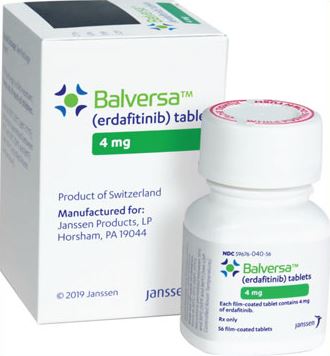Balversa (erdafitinib) – To treat adult patients with locally advanced or metastatic bladder cancer.

BALVERSA DOSAGE AND ADMINISTRATION
• Confirm the presence of FGFR genetic alterations in tumor specimens prior to initiation of treatment with BALVERSA.
• Recommended initial dosage: 8 mg orally once daily with a dose increase to 9 mg daily if criteria are met.
• Swallow whole with or without food.
BALVERSA INDICATIONS AND USAGE
BALVERSA is a kinase inhibitor indicated for the treatment of adult patients with locally advanced or metastatic urothelial carcinoma that has
• susceptible FGFR3 or FGFR2 genetic alterations and
• progressed during or following at least one line of prior platinum-containing chemotherapy including within 12 months of neoadjuvant or adjuvant
platinum-containing chemotherapy.
Select patients for therapy based on an FDA-approved companion diagnostic for BALVERSA.
This indication is approved under accelerated approval based on tumor response rate. Continued approval for this indication may be contingent upon verification and description of clinical benefit in confirmatory trials.
BALVERSA ADVERSE REACTIONS
The most common adverse reactions including laboratory abnormalities (≥20%) were phosphate increased, stomatitis, fatigue, creatinine increased, diarrhea, dry mouth, onycholysis, alanine aminotransferase increased, alkaline phosphatase increased, sodium decreased, decreased appetite, albumin decreased, dysgeusia, hemoglobin decreased, dry skin, aspartate aminotransferase increased, magnesium decreased, dry eye, alopecia, palmar-plantar erythrodysesthesia syndrome, constipation, phosphate decreased, abdominal pain, calcium increased, nausea, and sativa edibles musculoskeletal pain.
BALVERSA DRUG INTERACTIONS
• Strong CYP2C9 or CYP3A4 inhibitors: Consider alternative agents or monitor closely for adverse reactions.
• Strong CYP2C9 or CYP3A4 inducers: Avoid concomitant use with BALVERSA.
• Moderate CYP2C9 or CYP3A4 inducers: Increase BALVERSA dose up to 9 mg.
• Serum phosphate level-altering agents: Avoid concomitant use with agents that can alter serum phosphate levels before the initial dose modification period.
• CYP3A4 substrates: Avoid concomitant use with sensitive CYP3A4 substrates with narrow therapeutic indices.
• OCT2 substrates: Consider alternative agents or consider reducing the dose of OCT2 substrates based on tolerability.
• P-gp substrates: Separate BALVERSA administration by at least 6 hours before or after administration of P-gp substrates with narrow therapeutic indices.

